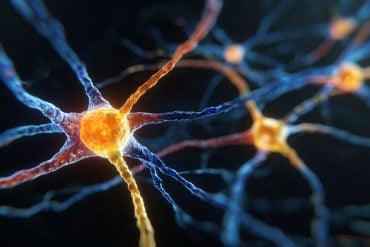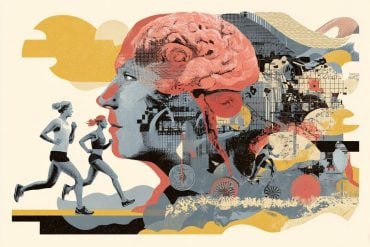Summary: Supplementing eNAMPT in older mice with that taken from the blood of younger mice boosts the production of NAD, staving off the effects of aging. The findings provide a potential avenue for anti-aging interventions in humans.
Source: WUSTL
New research has identified a novel approach to staving off the detrimental effects of aging, according to a study from Washington University School of Medicine in St. Louis.
The study suggests that a protein that is abundant in the blood of young mice plays a vital role in keeping mice healthy. With age, levels of this protein decline in mice and people, while health problems such as insulin resistance, weight gain, cognitive decline and vision loss increase. Supplementing older mice with the protein obtained from younger mice appears to slow this decline in health and extend the life spans of older mice by about 16 percent.
The study is published June 13 in the journal Cell Metabolism.
The circulating protein is an enzyme called eNAMPT, which is known to orchestrate a key step in the process cells use to make energy. With age, the body’s cells become less and less efficient at producing this fuel — called NAD — which is required to keep the body healthy. Washington University researchers have shown that supplementing eNAMPT in older mice with that of younger mice appears to be one route to boosting NAD fuel production and keeping aging at bay.
“We have found a totally new pathway toward healthy aging,” said senior author Shin-ichiro Imai, MD, PhD, a professor of developmental biology.
“That we can take eNAMPT from the blood of young mice and give it to older mice and see that the older mice show marked improvements in health — including increased physical activity and better sleep — is remarkable.”
Imai has long studied aging, using mice as stand-ins for people. Unlike other studies focused on transfusing whole blood from young mice to old mice, Imai’s group increased levels of a single blood component, eNAMPT, and showed its far-reaching effects, including improved insulin production, sleep quality, function of photoreceptors in the eye, and cognitive function in performance on memory tests, as well as increased running on a wheel. Imai’s group also has shown other ways to boost NAD levels in tissues throughout the body. Most notably, the researchers have studied the effects of giving oral doses of a molecule called NMN, the chemical eNAMPT produces. NMN is being tested in human clinical trials.
“We think the body has so many redundant systems to maintain proper NAD levels because it is so important,” Imai said. “Our work and others’ suggest it governs how long we live and how healthy we remain as we age. Since we know that NAD inevitably declines with age, whether in worms, fruit flies, mice or people, many researchers are interested in finding anti-aging interventions that might maintain NAD levels as we get older.”

Imai’s research has shown that the hypothalamus is a major control center for aging throughout the body, and it is directed in large part by eNAMPT, which is released into the blood from fat tissue. The hypothalamus governs vital processes such as body temperature, thirst, sleep, circadian rhythms and hormone levels. The researchers have shown that the hypothalamus manufactures NAD using eNAMPT that makes its way to the brain through the bloodstream after being released from fat tissue. They also showed that this eNAMPT is carried in small particles called extracellular vesicles. As levels of eNAMPT in the blood decline, the hypothalamus loses its ability to function properly, decreasing life span.
In an intriguing finding, Imai and first author Mitsukuni Yoshida, a doctoral student in Imai’s lab, showed that levels of eNAMPT in the blood were highly correlated with the number of days the mice lived. More eNAMPT meant a longer life span, and less meant a shorter one.
Scientists are seeking new ways to extend healthy life spans, and a new study in mice suggests a novel strategy. Researchers at Washington University School of Medicine in St. Louis have shown that supplementing older mice with an enzyme called eNAMPT from younger mice extends life spans in the older mice. The active mouse in the video was given the enzyme; the less active mouse was given saline. The mice are the same age. Credit: WUSTL.
The researchers also showed increased life span with delivering eNAMPT to normal old mice. All mice that received saline solution as a control had died before day 881, about 2.4 years. Of the mice that received eNAMPT, one is still alive as of this writing, surpassing 1,029 days, or about 2.8 years.
“We could predict, with surprising accuracy, how long mice would live based on their levels of circulating eNAMPT,” Imai said. “We don’t know yet if this association is present in people, but it does suggest that eNAMPT levels should be studied further to see if it could be used as a potential biomarker of aging.”
The study also found sex differences in levels of eNAMPT, with female mice consistently showing higher levels of the enzyme.
“We were surprised by the dramatic differences between the old mice that received the eNAMPT of young mice and old mice that received saline as a control,” Imai said. “These are old mice with no special genetic modifications, and when supplemented with eNAMPT, their wheel-running behaviors, sleep patterns and physical appearance — thicker, shinier fur, for example — resemble that of young mice.”
Imai and his colleagues, including co-author Rajendra Apte, MD, PhD, the Paul A. Cibis Distinguished Professor of Ophthalmology and Visual Sciences, noted that eNAMPT also is carried in extracellular vesicles in humans. As such, future studies should be done to investigate whether low levels are associated with disease in aging people and whether supplementing eNAMPT in extracellular vesicles could serve as an anti-aging intervention in older people, they said.
Funding: This work was supported by the Diabetes Research Center, grant number P30 DK020579; and Nutrition Obesity Research Center, grant number P30 DK56341. This work was mainly supported by grants from the National Institute on Aging, grant numbers AG037457 and AG047902; the American Federation for Aging Research, and the Tanaka Fund. A part of this study also was performed in a facility supported by the NCRR grant C06 RR015502. Further support was provided by JSPS KAKENHI, grant number JP18H03186; AMED, grant number JP18gm5010001h0001; the Takeda Science Foundation; and the Research Fund for Longevity Sciences from the National Center for Geriatrics and Gerontology (28-47). Imai and Satoh also are collaborating in the Project for Elucidating and Controlling Mechanisms of Aging and Longevity, organized by the Japan Agency for Medical Research and Development (AMED). Further support was provided by the Intellectual and Developmental Disabilities Research Center, grant numbers U54 HD087011; the NIH R01 EY019287, P30 EY02687, Vision Core Grant; the Starr Foundation; the Carl Marshall Reeves and Mildred Almen Reeves Foundation; the Bill and Emily Kuzma Family Gift for retinal research; a Physician-Scientist Award and a Nelson Trust Award from Research to Prevent Blindness; the Jeffrey Fort Innovation Fund; the Thome Foundation; and an unrestricted grant from Research to Prevent Blindness to the Department of Ophthalmology and Visual Sciences of Washington University School of Medicine. Further support was provided by the Washington University Medical Scientist Training Program, NIH grant number T32 GM007200; the Washington University Institute of Clinical and Translational Sciences, grant numbers UL1 TR002345 and TL1 TR002344; and the VitreoRetinal Surgery Foundation. Apte is a co-founder of Metro Midwest Biotech. All other authors have no financial interests.
Source:
WUSTL
Julia Evangelou Strait – WUSTL
Image Source:
The image is adapted from the WUSTL video.
Original Research: Closed access
“Extracellular Vesicle-Contained eNAMPT Delays Aging and Extends Lifespan in Mice”. Mitsukuni Yoshida, Akiko Satoh, Jonathan B. Lin, Kathryn F. Mills, Yo Sasaki, Nicholas Rensing, Michael Wong, Rajendra S. Apte, and others.
Cell Metabolism. doi:10.1016/j.cmet.2019.05.015
Abstract
Extracellular Vesicle-Contained eNAMPT Delays Aging and Extends Lifespan in Mice
Highlights
• Circulating levels of eNAMPT decline with age in both mice and humans
• Increasing eNAMPT promotes NAD +, counteracts aging, and extends healthspan in mice
• eNAMPT is contained exclusively in extracellular vesicles (EVs) in mice and humans
• Supplementing eNAMPT in EVs improves physical activity and extends lifespan in mice
Summary
Aging is a significant risk factor for impaired tissue functions and chronic diseases. Age-associated decline in systemic NAD + availability plays a critical role in regulating the aging process across many species. Here, we show that the circulating levels of extracellular nicotinamide phosphoribosyltransferase (eNAMPT) significantly decline with age in mice and humans. Increasing circulating eNAMPT levels in aged mice by adipose-tissue-specific overexpression of NAMPT increases NAD + levels in multiple tissues, thereby enhancing their functions and extending healthspan in female mice. Interestingly, eNAMPT is carried in extracellular vesicles (EVs) through systemic circulation in mice and humans. EV-contained eNAMPT is internalized into cells and enhances NAD + biosynthesis. Supplementing eNAMPT-containing EVs isolated from young mice significantly improves wheel-running activity and extends lifespan in aged mice. Our findings have revealed a novel EV-mediated delivery mechanism for eNAMPT, which promotes systemic NAD + biosynthesis and counteracts aging, suggesting a potential avenue for anti-aging intervention in humans.






